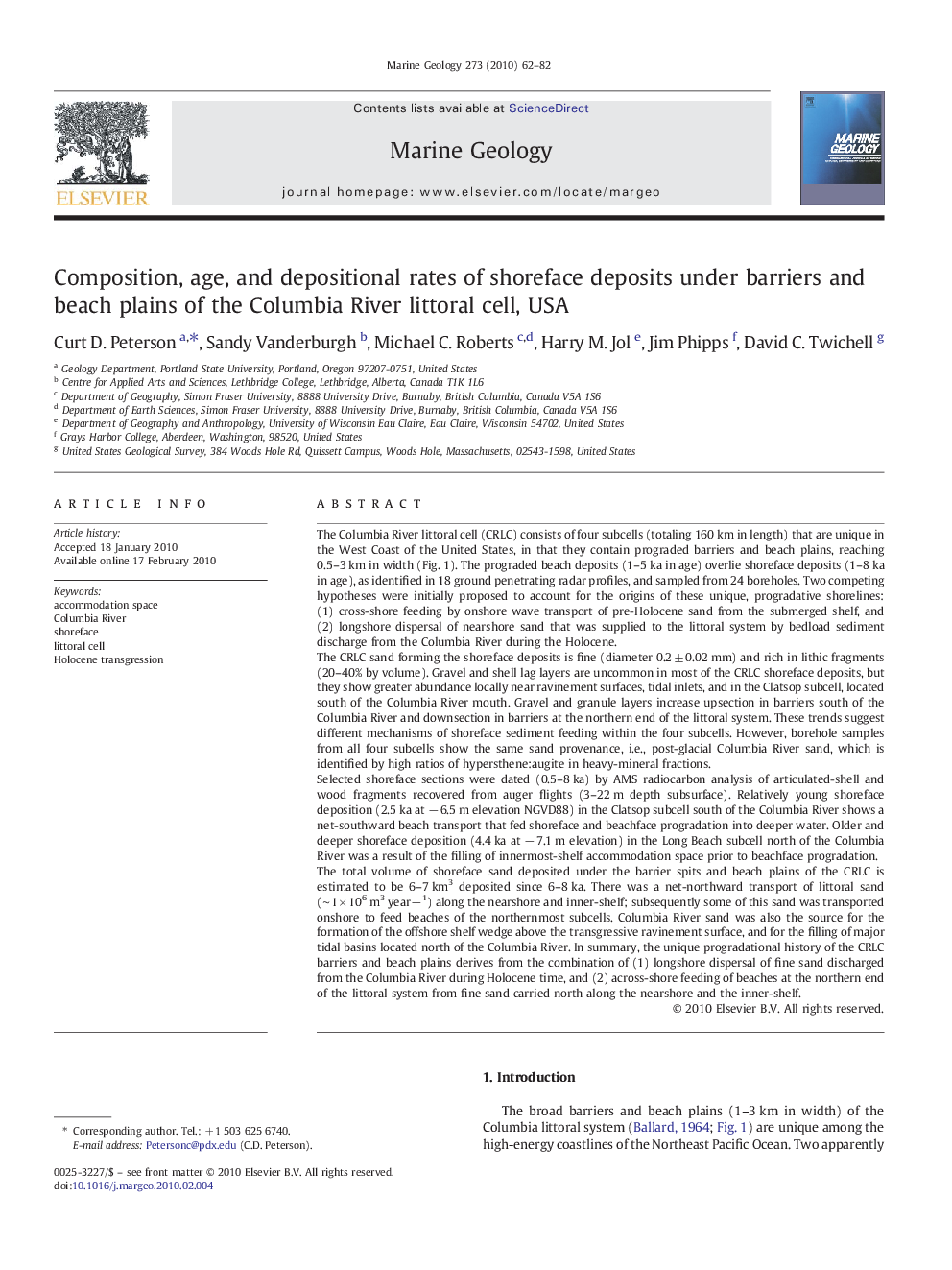| کد مقاله | کد نشریه | سال انتشار | مقاله انگلیسی | نسخه تمام متن |
|---|---|---|---|---|
| 4718873 | 1639148 | 2010 | 21 صفحه PDF | دانلود رایگان |

The Columbia River littoral cell (CRLC) consists of four subcells (totaling 160 km in length) that are unique in the West Coast of the United States, in that they contain prograded barriers and beach plains, reaching 0.5–3 km in width (Fig. 1). The prograded beach deposits (1–5 ka in age) overlie shoreface deposits (1–8 ka in age), as identified in 18 ground penetrating radar profiles, and sampled from 24 boreholes. Two competing hypotheses were initially proposed to account for the origins of these unique, progradative shorelines: (1) cross-shore feeding by onshore wave transport of pre-Holocene sand from the submerged shelf, and (2) longshore dispersal of nearshore sand that was supplied to the littoral system by bedload sediment discharge from the Columbia River during the Holocene.The CRLC sand forming the shoreface deposits is fine (diameter 0.2 ± 0.02 mm) and rich in lithic fragments (20–40% by volume). Gravel and shell lag layers are uncommon in most of the CRLC shoreface deposits, but they show greater abundance locally near ravinement surfaces, tidal inlets, and in the Clatsop subcell, located south of the Columbia River mouth. Gravel and granule layers increase upsection in barriers south of the Columbia River and downsection in barriers at the northern end of the littoral system. These trends suggest different mechanisms of shoreface sediment feeding within the four subcells. However, borehole samples from all four subcells show the same sand provenance, i.e., post-glacial Columbia River sand, which is identified by high ratios of hypersthene:augite in heavy-mineral fractions.Selected shoreface sections were dated (0.5–8 ka) by AMS radiocarbon analysis of articulated-shell and wood fragments recovered from auger flights (3–22 m depth subsurface). Relatively young shoreface deposition (2.5 ka at − 6.5 m elevation NGVD88) in the Clatsop subcell south of the Columbia River shows a net-southward beach transport that fed shoreface and beachface progradation into deeper water. Older and deeper shoreface deposition (4.4 ka at − 7.1 m elevation) in the Long Beach subcell north of the Columbia River was a result of the filling of innermost-shelf accommodation space prior to beachface progradation.The total volume of shoreface sand deposited under the barrier spits and beach plains of the CRLC is estimated to be 6–7 km3 deposited since 6–8 ka. There was a net-northward transport of littoral sand (∼ 1 × 106 m3 year− 1) along the nearshore and inner-shelf; subsequently some of this sand was transported onshore to feed beaches of the northernmost subcells. Columbia River sand was also the source for the formation of the offshore shelf wedge above the transgressive ravinement surface, and for the filling of major tidal basins located north of the Columbia River. In summary, the unique progradational history of the CRLC barriers and beach plains derives from the combination of (1) longshore dispersal of fine sand discharged from the Columbia River during Holocene time, and (2) across-shore feeding of beaches at the northern end of the littoral system from fine sand carried north along the nearshore and the inner-shelf.
Journal: Marine Geology - Volume 273, Issues 1–4, 1 August 2010, Pages 62–82